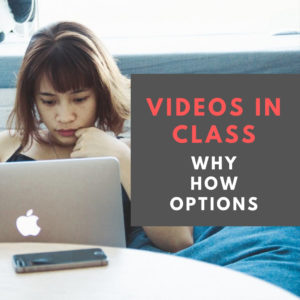 When I started teaching, videos were used only for a few reasons: to teach historical events, as a prize for something students did well, or for the sub to fill the time while I was out. A lot has changed since then, most importantly, teachers now recognize that students learn in a variety of ways, only one of which is via text.
When I started teaching, videos were used only for a few reasons: to teach historical events, as a prize for something students did well, or for the sub to fill the time while I was out. A lot has changed since then, most importantly, teachers now recognize that students learn in a variety of ways, only one of which is via text.
Why use videos
It turns out, videos are much more than the distraction from life Hollywood would have us believe or the visual encyclopedia those educational movies of a decade ago always were. Today’s videos are highly-effective learning tools, cerebral entertainment, and well-suited to visual and auditory learners. Videos are entertaining but not in the sit-back-and-eat-popcorn sort of way that you experience with Netflix or the theatre. Rather than check out of the world, viewers willingly dig deeply into the topic in a way that can’t happen from a textbook or lecture. The videos you show in your classroom likely will be professionally produced with a script that appeals to short attention spans and draws students into the excitement of the material. Students will engage actively meaning you can expect them to take notes (digital is fine and rewind to rewatch either to review, to ensure they got everything they should, or simply for the entertainment.
Once you accept the reality that learning can take place outside of a textbook, reading, or notetaking, it’s not hard to see the great value of videos. Done well, students retain more information, understand concepts more rapidly, and are more enthusiastic about what they are learning. Videos have become a cornerstone to the effectiveness of self-paced learning programs like Purpose-driven Learning and Unschooling. Teachers provide the essential question and big idea, and then share a collection of videos students can select from as they design their own learning.
How to use videos
When using videos in class, be sure to preview first and then pick those best-suited to your student group. There are so many places to find videos, you’ll have no problem selecting one perfect for your class. A few popular curators are YouTube, TED Ed, C-Span, or others from this long list of great (mostly)-free video collections.
As you select videos, consider Dr Ruben Puentedura’s SAMR Model. If you’re not sure what the SAMR Model is, click the link for information. For the rest, here’s how using videos will satisfy the different SAMR stages:
S (Substitution): Use videos that support your lesson plans in place of a textbook, a worksheet, or a digital tool, such as a slideshow with embedded videos to push out a lesson plan in your absence.
A (Augmentation): Use videos to expand learning; you may provide a list of videos (say, to discuss a calculus concept) that students can pick from.
M (Modification): Use videos to modify learning by widening the discussion. In this case, expect students to make connections using higher-order thinking.
R (Redefinition): Redefine your lesson plan by allowing students to access videos that explore their particular interest in a topic; encourage students to engage in higher-order thinking by creating a video that shares their thinking on the lesson’s essential question.
Before showing the video, review your expectations:
What they WON’T do is relax, put books and note-taking tools away, and prepare to be entertained.
What they WILL do is watch closely, be prepared to ask/answer questions, take notes as appropriate, and relate what they see to the lesson’s essential question.
Suggestion: If the video has closed captioning, turn it on. This differentiates for those students who learn better by reading while still accommodating visual learners.
Here are some great ideas on using videos that will engage students not as passive observers but higher-order thinkers:
- take students on impossible field trips — inside the human body, or off to Jupiter
- take students around the globe, to meet new people and hear their ideas
- illustrate complex, abstract concepts through animated, 3-D images
- show experiments that can’t be done in class
- bring great literature, plays, music, or important scenes from history into the room
- provide background knowledge on topics being discussed — not for testing but to round out learning or for pure enjoyment
- make videos available to English Language Learners for the specific purpose of providing them with a resource that is on-topic, always available, and rewindable
- personalize learning by differentiating lessons with videos for individual students
3 Great Video Tools that Modify and Redefine Learning
When it comes to video, students shouldn’t be passive receivers of what’s happening on the screen. They should be active participants in viewing, sharing ideas, testing understanding, and blending this new knowledge with everything they know. They need to comprehend and critique, read and react, and get and give knowledge. Below are four great tools to help you personalize videos to your class needs, enrich content, and assess student understanding while watching. Pick what works best for you:
EdPuzzle
EdPuzzle allows teachers to select a video from Khan Academy, Crash Course, YouTube or many other video curators and then enhance it with questions, comments, or even the teacher’s own voice. As students watch and interact, the teacher can track understanding and how many times the student watched it, and then come away with good metrics for what worked or didn’t.
EdPuzzle is free for students and teachers and available on desktops, iOS, Chrome, or Android.
PlayPosit
PlayPosit makes it easy to create interactive videos that engage and excite students. Teachers pick the video; enrich it with a variety of options like multiple choice questions, class discussions and graded fill-in-the blanks; push it out to their class; and then track data showing effectiveness. It integrates with many LMSs (like Schoology, Blackboard, Moodle, and more) as well as many video host providers (like YouTube, TeacherTube, Khan Academy, and more).
Touchcast Studio
Touchcast Studio is a free iOS app that allows you to record video, edit clips, add dynamic interactive features (like soundtracks, graphics, and web pages), and then publish. What I really like about this tool is that it allows you to take a video and add “hotspots” with interactive elements.
A note from CommonSense Media: While there are some great templates, some may not be appropriate for all classrooms. Teacher monitoring is recommended.
***
The cerebral entertainment of videos is hard to overstate. Done right, you will find no better tool for learning.
@playposit
#edpuzzle
More on videos
Edit and Share Videos Like a Rock Star
10 Reasons Why Videos are Great Educational Tools
8 Reasons Why Students Should Create Videos and 15 Webtools to Do That
Jacqui Murray has been teaching K-18 technology for 30 years. She is the editor/author of over a hundred tech ed resources including a K-12 technology curriculum, K-8 keyboard curriculum, K-8 Digital Citizenship curriculum. She is an adjunct professor in tech ed, Master Teacher, webmaster for four blogs, an Amazon Vine Voice, CSTA presentation reviewer, freelance journalist on tech ed topics, contributor to NEA Today, and author of the tech thrillers, To Hunt a Sub and Twenty-four Days. You can find her resources at Structured Learning.




































